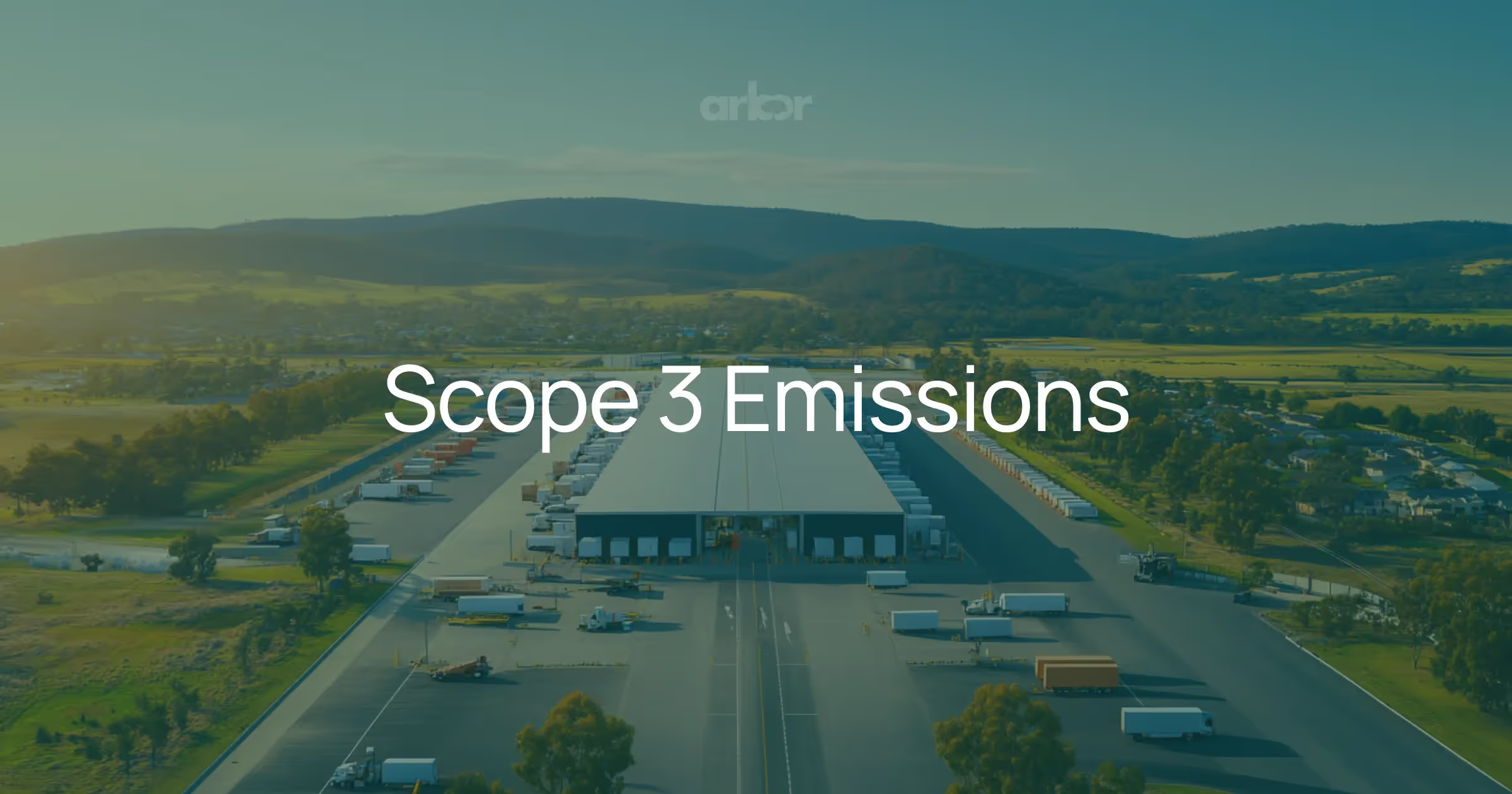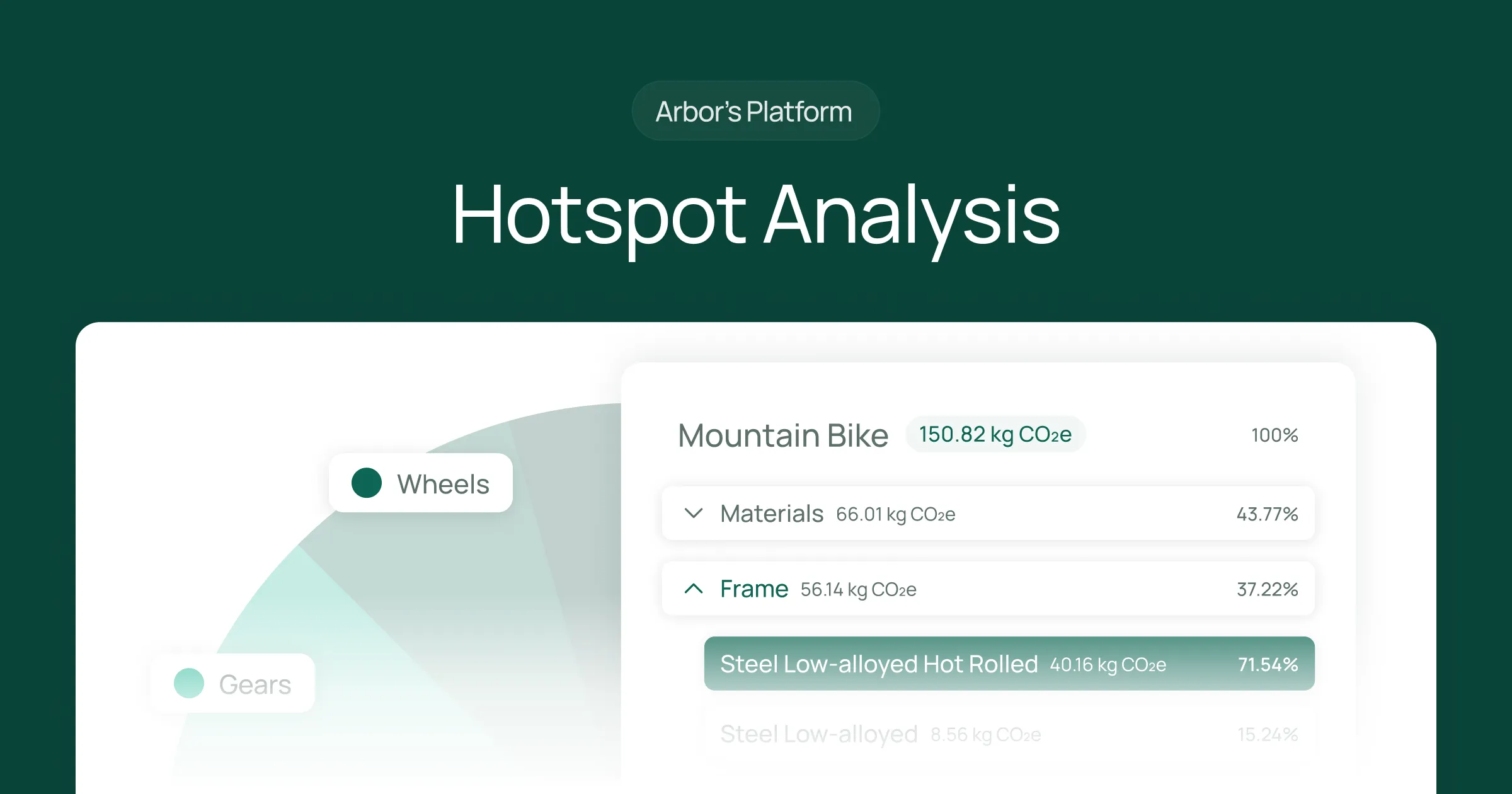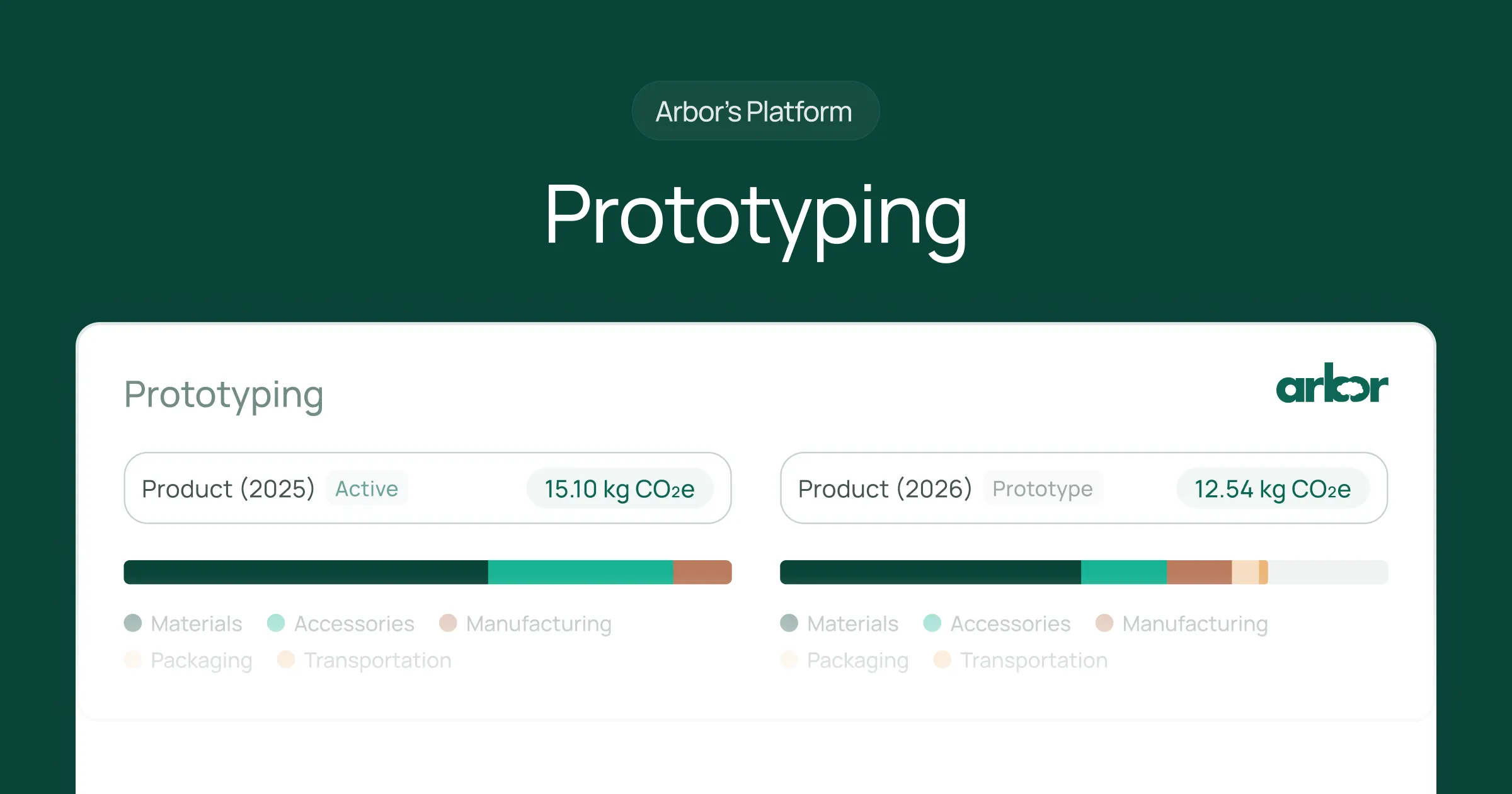- Scope 3 emissions encompass all indirect emissions within a company's value chain, typically accounting for 90% of the total carbon footprint. They are divided into 15 categories, including purchased goods, transportation, product use, and investments.
- Measuring Scope 3 emissions is challenging due to data availability issues and the need for extensive collaboration with suppliers. Companies often start with estimates and improve data accuracy over time.
- Key strategies for reducing Scope 3 emissions include engaging suppliers to decarbonize, redesigning products for energy efficiency and circularity, and optimizing logistics.
- Growing regulatory and investor pressure, such as the EU's CSRD, makes managing Scope 3 emissions a business necessity for risk management and maintaining a competitive edge.
- Carbon accounting platforms, such as Arbor, automate the measurement process, providing the speed, accuracy, and scalability needed to manage complex value chain emissions effectively.
For most companies, the largest part of their carbon footprint does not come from the buildings they own or the cars they drive.
It comes from their supply chain.
These indirect impacts are known as Scope 3 emissions, and they often represent the most significant challenge and the greatest opportunity for meaningful climate action. If your business is serious about decarbonization, understanding your value chain emissions is the most important step.
Explaining Scope 3 emissions requires an understanding of the foundational concepts of all three emission scopes, detailing the 15 categories of Scope 3, and outlining methods for calculation and reduction. Addressing your company's full carbon footprint is essential for meeting stakeholder expectations and navigating the transition to a low-carbon economy.
Defining the scopes: An overview of Scope 1, 2, and 3 emissions
To properly manage greenhouse gas (GHG) emissions, we first need to categorize them. The GHG Protocol, a global standard, divides emissions into three "scopes." This framework is the foundation of corporate carbon accounting.
Scope 1: Direct emissions
Scope 1 emissions are direct GHG releases from sources your company owns or controls. Think of it as the smoke coming directly from your own stacks.
Examples include:
- Fuel combustion in company vehicles, boilers, or furnaces.
- Emissions from chemical processing during manufacturing.
- Fugitive emissions, such as refrigerant leaks from air conditioning units.
Companies have the most operational control over these emissions, making them a common starting point for efforts to reduce them.
Scope 2: Indirect emissions from purchased energy
Scope 2 covers indirect emissions from the generation of purchased electricity, steam, heating, or cooling. While the emissions happen at the power plant, they are a direct result of your company's energy consumption.
Your choice of energy provider and your consumption habits directly influence this number. You can reduce these energy emissions by improving energy efficiency or purchasing renewable energy.
Scope 3: Other indirect emissions (value chain emissions)
Scope 3 is the big one. It includes all other indirect emissions that occur in your company's value chain, from sources you don't own or control. This category covers everything from the materials your suppliers buy to what happens to your products after you sell them.
One company's Scope 1 or 2 emissions are another company's Scope 3.
For example, the emissions from a supplier's factory (their Scope 1) are part of your Scope 3 emissions for purchased goods. This illustrates the interconnectedness of modern commerce and highlights the importance of collaboration in reducing overall carbon emissions.
Scope 1, 2, and 3 emissions visual

The significance of Scope 3: Why indirect emissions matter most
The focus on Scope 3 emissions is growing because they represent the majority of a company's total carbon footprint.
For many businesses, value chain emissions account for 75% to 95% of their total greenhouse gas (GHG) impact. In certain sectors, such as financial services, this figure can be even higher. A climate strategy that ignores Scope 3 is incomplete.
Here’s why it’s so important:
Comprehensive risk assessment
Measuring Scope 3 gives you a full picture of your climate-related risks. You cannot accurately assess transition risks, such as carbon taxes on your suppliers, without quantifying your value chain emissions. Supply chain risk assessments help identify vulnerabilities in your supply chain.
Driving value chain action
You cannot reduce Scope 3 emissions alone. The process requires partnering with suppliers, customers, and other partners. This collaboration can foster innovation and create shared responsibility for decarbonization.
Meeting stakeholder and regulatory demands
Investors, regulators, and customers are all demanding transparency on Scope 3 emissions. Regulations, such as the EU's Corporate Sustainability Reporting Directive (CSRD), are making Scope 3 reporting mandatory. Initiatives like the Science Based Targets initiative (SBTi) require companies to include Scope 3 emissions if they account for more than 40% of their total footprint, which is the case for most businesses.
15 categories of Scope 3 emissions
The GHG Protocol breaks down Scope 3 into 15 distinct categories to provide a structured approach to carbon accounting. These are divided into upstream (before your operations) and downstream (after your operations) activities.
Upstream vs. downstream emissions: What's the difference?
Understanding the distinction between upstream versus downstream emissions is fundamental to managing your Scope 3 footprint. Think of your company's operations as the central point.
Upstream activities are everything that happens before your company gets involved, including the emissions generated to produce the goods and services you purchase. This includes raw material extraction, your suppliers' manufacturing processes, and transportation to your facilities. In the upstream vs downstream comparison, upstream is about your inputs.
Conversely, downstream activities cover everything that happens after your products or services leave your control. This includes the transportation of your products to customers, the energy your products consume during their use, and their end-of-life disposal.
The distinction between downstream vs upstream is critical for strategy; upstream emissions are managed through supplier engagement and procurement choices, while downstream emissions require a focus on product design, customer education, and end-of-life solutions.
Upstream emissions
Upstream emissions are related to purchased or acquired goods and services.
Category 1: Purchased goods and services
Emissions from producing the goods and services you buy. This is often the largest category.
Category 2: Capital goods
Emissions from producing long-lasting assets like machinery, buildings, and vehicles.
Category 3: Fuel-and-energy-related activities
Upstream emissions of the fuels and electricity you purchase, including extraction, transmission and distribution (T&D) losses.
Category 4: Upstream transportation and distribution
Emissions from the third-party transport of goods you purchase.
Category 5: Waste generated in operations
Emissions from disposing of your company's waste in third-party facilities (e.g., landfill, incineration).
Category 6: Business travel
Emissions from employee travel for business in vehicles not owned by your company (e.g., flights, trains, rental cars).
Category 7: Employee commuting
Emissions from employees travelling between their homes and worksites.
Category 8: Upstream leased assets
Emissions from operating assets you lease but do not control.
Downstream emissions
Downstream emissions are related to the goods and services you sell.
Category 9: Downstream transportation and distribution
Emissions from transporting and distributing your sold products to the final consumer.
Category 10: Processing of sold products
Emissions from third-party processing of your intermediate products.
Category 11: Use of sold products
Emissions from the use of your sold products. This is a significant category for items that consume energy, like electronics or vehicles.
Category 12: End-of-life treatment of sold products
Emissions from the disposal or recycling of your products after consumers are done with them.
Category 13: Downstream leased assets
Emissions from the operation of assets you own and lease to others.
Category 14: Franchises
Emissions from the operation of your franchises.
Category 15: Investments
Emissions associated with your company's investments, also known as "financed emissions." This is the key category for financial institutions.
Upstream versus downstream emissions in Scope 3
This table summarizes the 15 categories for easy reference:
The measurement challenge in Scope 3 accounting
Accounting for Scope 3 emissions is a challenging task. The main difficulty is the reliance on data from outside your organization.
- Data availability and quality: Many suppliers, especially smaller ones, do not measure their own emissions. This forces companies to use secondary data, such as industry averages, which can be inaccurate.
- Supplier engagement: Your value chain can have thousands of suppliers. Engaging all of them to collect data is a huge task. Many individuals may be reluctant to share data due to concerns about cost or confidentiality.
- Methodological difficulties: The GHG Protocol offers several calculation methods. Choosing the right one for each category can be complex and lead to inconsistent reporting if not done carefully.
- Resource intensity: Comprehensive Scope 3 accounting requires significant time, money, and internal expertise.
Overcoming these challenges requires a shift from a simple compliance mindset to one of value chain collaboration and strategic data management.
Frameworks and methodologies for Scope 3 quantification
A credible Scope 3 inventory relies on established frameworks. The GHG Protocol's Corporate Value Chain (Scope 3) Standard is the global benchmark.
The process generally involves three steps:
1. Determine relevant categories
Identify which of the 15 categories are significant for your company based on size, influence, and risk.
2. Estimate GHG emissions
Collect activity data for each relevant category and apply the correct emission factors.
3. Improve over time
Scope 3 accounting is an iterative process. You should aim to continually improve the accuracy and completeness of your data, transitioning from estimates to primary data where possible.
Common calculation approaches
There are several methods to calculate Scope 3 emissions. A hybrid approach (what Arbor uses) is often the most practical.
{{cta}}
Strategic levers for Scope 3 reduction
The goal of carbon accounting is reduction. A strategic approach focuses on the biggest emission sources, or "emission hotspots."
Supplier engagement strategies
Since a significant portion of your Scope 3 footprint is attributed to suppliers, strong engagement is crucial.
- Collaborate and communicate: Clearly state your goals and expectations.
- Build capability: Provide training and resources to help suppliers measure and reduce their emissions.
- Offer incentives: Use preferential procurement terms or rewards to motivate suppliers.
- Integrate carbon performance into procurement: Make it a criterion in your purchasing decisions.
Product design and innovation
Your product design choices significantly impact emissions throughout the product's lifecycle.
- Use Lifecycle Assessment (LCA): Understand the full carbon footprint of your products.
- Design for energy efficiency: Reduce emissions from the "use of sold products" category.
- Design for circularity: Make products durable, repairable, and recyclable.
- Substitute materials: Switch to lower-carbon materials like recycled content.
How Arbor simplifies Scope 3 carbon accounting
The complexity of measuring and managing Scope 3 requires powerful tools. A manual approach is often inefficient and prone to errors. Arbor's automated carbon accounting platform is designed to solve these challenges.
Our platform helps you measure, manage, and reduce your carbon footprint across all scopes. We specialize in Product Carbon Footprints (PCFs) and Life Cycle Assessments (LCAs), which are automated for speed and accuracy.
Arbor allows you to:
- Calculate emissions quickly: Handle thousands of products in the time it takes competitors to do one. We help you get an emissions baseline with the primary data you already collect.
- Enhance accuracy: Our platform utilizes region-specific data, enabling you to analyze your supply chain at a granular level. It automatically fills data gaps with best-in-class secondary data.
- Identify carbon hotspots: Pinpoint the origins of your emissions to focus your reduction efforts where they will have the most impact.
- Report with confidence: Generate trusted, accurate carbon data for regulatory compliance and stakeholder communication.
The path forward
Managing Scope 3 emissions is no longer optional. It is central to any credible climate strategy and a core component of modern business resilience.
By embedding Scope 3 management into your core strategy, investing in the right tools and capabilities, and collaborating with your value chain partners, you can drive meaningful decarbonization.
Ready to measure your company's Scope 3 emissions?
Talk to a carbon expert today or learn more about Arbor’s Scope 3 reporting
Measure your carbon emissions with Arbor
Simple, easy carbon accounting.

FAQ
What is the easiest way to automate carbon management and move away from manual measurement?
To simplify and streamline the process of carbon management, transitioning to a dedicated carbon management platform is the most effective method. Platforms like Arbor are designed to automate the monitoring and reporting of carbon emissions. This approach minimizes the need for manual interventions, making the process more efficient and less prone to human error. By integrating a robust carbon management system, companies can ensure accurate tracking and manage their environmental impact effortlessly.
What are the highest overall emissions sources according to the World Resources Institute (WRI)?
The World Resources Institute (WRI) identifies the primary sources of global emissions as predominantly stemming from three main sectors:
- Energy: This sector is the most significant contributor, accounting for 75.6% of total emissions, which equals approximately 37.6 GtCO2e.
- Agriculture: Responsible for 11.6% of emissions, this amounts to about 5.8 GtCO2e.
- Industrial Processes: These contribute 6.1% of the total emissions, translating to around 3.1 GtCO2e.
These figures highlight where the most impactful efforts for reduction can be focused.
Do scope 3 emissions include the risk of double-counting and how can organizations prevent double-counting within their inventory categories?
To delve into the complexities of double-counting in Scope 3 emissions, it's important to note that organizations can actively work on minimizing this risk by becoming well-acquainted with the different emissions categories. By doing so, they can more effectively assign ambiguous emissions to a single category, reducing the chances of overlap. Furthermore, if double-counting is unavoidable, organizations should include a clear explanation within their emissions disclosure, ensuring transparency.
Additionally, when considering double-counting across various organizations and their respective value chains, the intricacies increase. Nonetheless, this should not justify the exclusion of emissions from an organization’s own inventory, except where explicitly required by reporting guidelines. Emphasizing these practices ensures a more accurate and responsible approach to managing Scope 3 emissions, aligning with broader environmental accountability and reporting standards.
How can organizations measure and disclose their scope 3 emissions using Arbor’s carbon accounting platform?
Streamlining Scope 3 Emission Tracking with Arbor's Carbon Accounting Platform
Understanding Scope 3 Emissions
Scope 3 emissions encompass all indirect emissions that occur in a company's value chain. These include emissions associated with both upstream and downstream activities, making their tracking and management critical yet complex. Due to their indirect nature, many organizations struggle with how to effectively measure and report these emissions.
Leveraging Arbor for Effective Management
Arbor's carbon accounting platform simplifies this intricate process. It offers an integrated solution that automates data collection and emission calculations, reducing the need for manual intervention and thus mitigating the risk of errors. Here’s how organizations can leverage Arbor to their advantage:
- Data Integration: Arbor's platform can seamlessly integrate with existing organizational systems to gather necessary data from various sources across the value chain.
- Automated Calculations: After data collection, the platform utilizes established protocols to automatically calculate the emissions, ensuring accuracy and consistency.
- Comprehensive Reporting: Arbor not only measures but also helps in crafting detailed reports that can be disclosed to stakeholders and regulatory bodies. This assists organizations in maintaining transparency in their sustainability efforts.
- Actionable Insights: Beyond measurement and reporting, the platform provides insights that can help in making strategic decisions to reduce emissions.
By using Arbor's all-in-one carbon accounting platform, organizations can efficiently measure and disclose their Scope 3 emissions, thereby enhancing their environmental responsibility while ensuring compliance with global sustainability standards. This approach not only supports corporate transparency but also fosters long-term sustainability commitments. Want to learn even more? Read our latest guide on Scope 1, 2, and 3 Emissions. Or check out a deep dive on each individual scope! Scope 1 Emissions, Scope 2 Emissions or Scope 3 Emissions.



%20Directive.webp)


.webp)











%20Arbor.avif)





%20Arbor.avif)


.avif)






%20Arbor%20Canada.avif)

.avif)
%20Arbor.avif)
.avif)






_.avif)
.avif)
%20Arbor.avif)




%20Software%20and%20Tools.avif)





.avif)
.avif)




%20EU%20Regulation.avif)












.avif)


%20Arbor.avif)









_%20_%20Carbon%20101.avif)







.avif)

.avif)
.avif)









